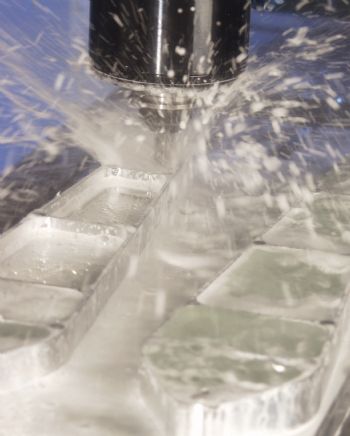
An aerospace manufacturer recently achieved worthwhile energy savings in CNC machining by using the most appropriate coolant. The company took advantage of a ‘sustainable manufacturing’ initiative sponsored by the US Air Force and applied one of its flexible machining cells (based on a 10-year-old horizontal machining centre) to the project, with the aim of establishing just how much energy could be saved when machining a titanium 6AI-4V part with deep pockets.
Using a power meter, researchers measured the effects of various energy-saving efforts during machining. They discovered that choices relating to tools, coolant, programming and machining parameters can combine to reduce energy use by up to 73% of what the plant’s established processes would normally consume.
The USAF funded the study to prepare suppliers for potentially higher energy costs in the future, and one of the main areas of focus was the effectiveness of through-tool coolant delivery.
Standard solid-carbide end mills using only flood coolant were run against otherwise identical end mills that had been modified to deliver coolant through ports near the flute tips. Both tests used TRIM MicroSol 585 from Master Chemical (
www.masterchemical.com), which was selected against four competitor coolants following trials.
While tool life would be the determining factor, the chosen coolant had to address numerous secondary issues. For instance, it had to minimise mist and eliminate any sticky residue that might cause the titanium chips to adhere to the machine tool.
Each candidate fluid was run at 6% concentration, diluted in de-ionised water. After the machining tests were completed, laboratory tests were run to compare the fluids for these non-cutting functions along with health and safety concerns, bio-stability and sump life.
Once TRIM MicroSol 585 had been selected, research continued and through-tool delivery provided measurably superior tool life in a number of ways. Not only did tool life improve, the wear from flute to flute on the same tool was more consistent.
This effectively extends the tool life advantage; if a tool can be trusted to wear predictably, it can be trusted to remain ‘in cut’ longer. The team’s testing of through-tool coolant demonstrated tool life improvements of as much as 30%.
Monte Dhatt, global aerospace manager at Master Chemical, said: “Coolant is vital to tool life, and selecting the correct chemistries will immensely improve tooling performance. Coolant selection considerations should include the type of machine, the materials being cut, operations, cycle time, tooling type, quantity of machine tramp oil, water type — such as de-ionised — and hardness, operator contact, foam and filtration.
“Through-tool operations typically use high pressure in the range 1,000-1,500psi. With high pressure, you want to use coolants that are low foaming and can break the foam quickly, otherwise spill-overs can occur.
"Modern machines are equipped with sensors that will stop them in mid-cycle if a spill-over is sensed, but this can be very costly as a part can be scrapped in mid-cut. Typically, synthetic and semi-synthetic chemistries will provide the best foam control.”
Energy savings — and more
The machining process that combined these improvements with others relating to cutting tools and programming techniques consumed 0.32kWhr/in3, a 73% reduction in energy compared with the way the plant machined parts before the sustainability research began.
As a result of these findings, various parts have been re-programmed for cycle time savings. The findings of the sustainability testing are particularly promising for the aerospace manufacturer — not only for energy reduction, but also for cost reduction and increased capacity resulting from cycle time improvements.
Although Master Chemical admits that, before the study, it did not consider energy savings specifically during its development process, the company always preaches the overall cost of correct coolant selection and coolant management.
Mr Dhatt said: “Cost savings — including energy — are always something we can measure for customers. This particular customer is now using TRIM MicroSol 585XT, which is an upgrade to the original formula. Foam and sump life were improved to address minor shortfalls identified in the study.
“In fact, the project has allowed us to establish a corporate contract with the company and expand the use of this fluid in many of its other facilities; and while it is well suited to machining and grinding mixed metals, TRIM MicroSol 585XT is particularly suitable when machining titanium alloys.
“Finally, it’s worth addressing the issue of boron, which is typically included to assist with ferrous corrosion inhibition on parts and machine tools. Although TRIM MicroSol 585XT contains elemental boron, any boric acid has been fully reacted in the formula, so there is no free boric acid, which is an item of concern for some manufacturers.”